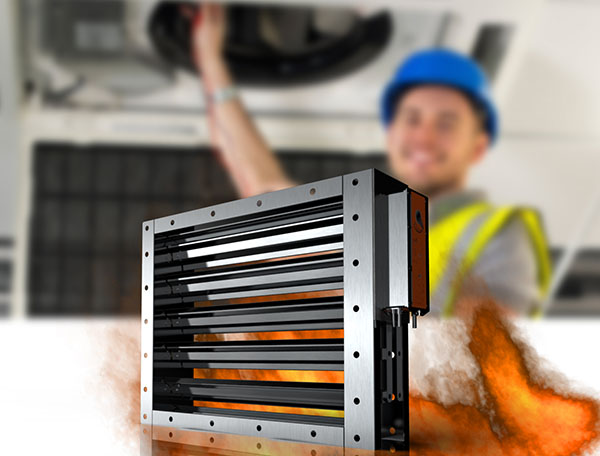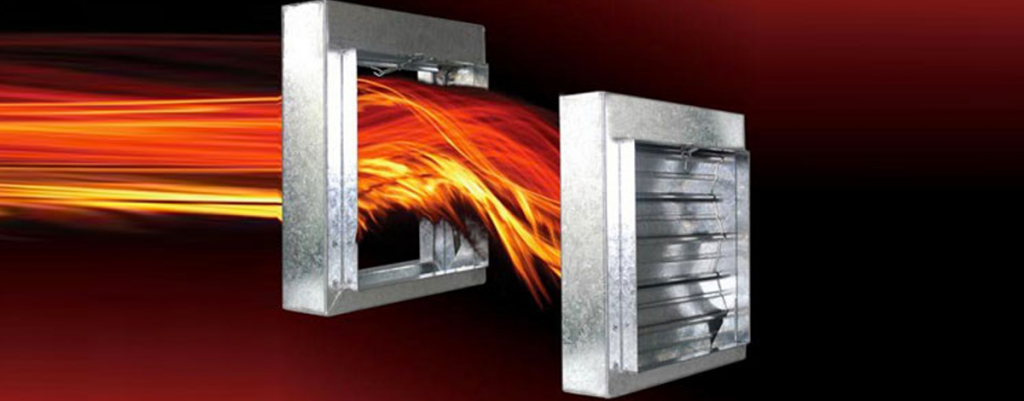Fires in commercial properties are thankfully rare, but they do happen. No matter how careful you are and how much you minimise your risk, sometimes fires do occur. Human error, electrical faults and downright bad luck, can all soon turn a small spark into a blazing inferno. As so many commercial properties have a HVAC system or ductwork installed, that fire can soon spread through the building posing a huge risk to both property and life. If a fire does occur it’s important to contain it for as long as possible to allow for the emergency services to respond and for the fire to be brought under control.
A properly installed and maintained fire safety system is essential. Fire dampers are a key part of a fire safety system.
What is a fire damper?
Fire and smoke dampers are a simple fire safety measure that are fitted throughout ductwork system. If a fire resistant wall is breached by ductwork, then a fire damper will be installed to block the ductwork in the event of a fire. This will help to contain both fire and smoke, slowing down its spread and allowing more time for safe evacuation and for the fire to be brought under control. Fittings will usually be made from galvanised steel, and they can be vertical or horizontal in their orientation depending on the way in which it’s required to close a particular duct.
Types of Fire Damper

There are a range of different fire damper types each more suitable for particular applications.
Dynamic dampers are installed in vertical barriers and usually contain a spring-loaded mechanism. If a fire occurs, the mechanism will be released and the doors of the damper will then shut closed. The fan in the system will keep running. This will, in turn, build up pressure helping to keep the fire damper door closed.
Static dampers are usually installed in horizontal barriers and have a curtain-like design. If a fire should occur the curtain will drop. This prevents the passage of heat, flames and smoke and allows more time for the building to be evacuated and the fire to be put out before it spreads. These are installed in ducts where the fans in the system will cease to operate in the event of a fire.
Fire/smoke dampers are designed to block smoke and fire together and, as a result, are a popular choice. In some cases however, they may not be appropriate. Often, allowing smoke to escape from the fire into other parts of the building can be an important means by which to alert people in other parts of the building that there is a fire. Smoke alarms can also be triggered by escaping smoke giving extra warning that there is a fire in the building.
How do they work?
Fire dampers are installed in ducts to prevent flames from crossing a fire barrier. They can be installed near the floor or the wall, as is appropriate. When a fire occurs the fire damper will respond to the heat, and slam shut when the temperature in the room reaches a certain point. This creates a fireproof wall helping to stop fire from spreading through the ductwork and rapidly becoming out of control.
The more time you have, the better the chances are of minimising the threat to human safety and bringing the fire under control. Fire dampers are only of use if they work correctly, which is why it’s important that they are regularly tested.
Why should they be tested?
Fire dampers are a key part of a building’s passive fire protection. To ensure that everything is working as it should it needs to be tested and maintained regularly. If your fire dampers are ever needed you need to be confident that they will work as expected.
Failure to maintain dampers, as well as a poor upkeep or initial installation can lead to a range of issues developing, all of which could present problems in the event of a fire. Dirt, rust and disintegration can all cause them to fail to function properly. If they fail, fire and smoke will then move quickly through the ductwork, causing the fire to rapidly grow out of control.

As a critical part of your fire safety infrastructure, it’s a legal requirement for fire dampers to be tested at least once a year. While this is the minimum requirement, it can often be sensible to ensure they’re tested at least twice a year. They should be tested at regular intervals by a competent person, upon completion and then at least once a year afterwards. If faults are found, repairs or replacements should be made immediately.
Testing fire dampers is just as essential as regularly testing fire extinguishers and the safety of fire escape routes. As a vital part of your fire safety infrastructure, if fire dampers don’t work they may compromise the whole fire safety system on which the safety of your staff and business property depends.
Speak to us about Fire Damper Testing
A comprehensive fire damper testing service
ECS Yorkshire provides fire damper testing in the North of England. Our comprehensive service pays attention to detail, and thoroughly checks every element to ensure that the security and integrity of a building’s fire safety infrastructure is compliant and strong.
To find out more about our service call 01535 600688 or email info@ecs-yorkshire.co.uk

